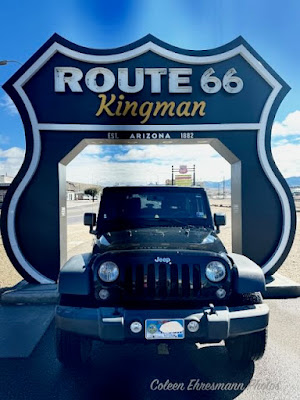It is 267 miles from Needles CA where we started driving Route 66 (when it was available) to our destination in Winslow AZ, our final Route 66 location. There were three towns on that stretch I thought were interesting and worthy of spending some time. You have seen the blog post on the ghost town of Two Guns, my first wish I had more time location.
Kingman is the second town on my if I had more time list. Most of the historic stops in the town were located within 0.3 distance. The town is easy to drive, although very busy during the noon hour.
the former railroad depot is now the Visitors Center and a museum
train car and 1928 steam engine in Railroad Park
and at the Visitors Center & Museum along the railroad tracks
In the hour or so we spent in Kingman, there were several trains that went through town.
This elevation notation was about 10 feet from the ground on the Visitors Center wall.
mileage from Kingman to other Route 66 major cities
a drive through the Route 66 sign near the Visitors Center
colorful Mr. D'z Route 66 Diner (still operating)
a triangular marker noting the history of the area
Kingman was founded in 1882 as a railroad siding
Edward Beale was commanded to build a Federal Wagon Road
across the 35th parallel passing through the area in 1857
His secondary orders were to test the feasibility of the use of camels
as pack animals in the Southwestern desert. ~ Wikipedia
Beale has quite the military and government accomplishments
military officer (navy & army), frontiersman, and explorer
Superintendent of Indian Affairs in CA, surveyor, rancher,
Ambassador to Austria-Hungary 1876-1877
respected Washington DC host
But it is his story as Lt. of the Camel Corps that is so interesting. (Hi Jolly monument in Quartzite AZ)
Before Beale’s survey expedition (Federal Wagon Road), the first camels arrived from Africa in early 1857. In March, the Secretary of War ordered the formation of the 1st U.S. Army Camel Corps and appointed 35-year-old Lieutenant Edward Beale to command it.
Beale used 25 camels on his first survey expedition, loading them with supplies. The soldiers hated the animals for their ornery disposition, and Beale, at first, agreed. However, over time, he developed an appreciation for their ability, and by the time the expedition reached California, Beale believed in the camels’ worth. He utilized them again in another expedition in 1858-59 that extended the road from Fort Smith, Arkansas.
Beale bought some of the camels once they were declared surplus. Hi Jolly was the camel driver/trainer for the survey expedition.
However, the camels scared the horses and mules, and the vast majority of soldiers refused to learn to ride them. Before long, critics claimed that the Camel Corps was a waste of money. Ultimately, the Army declined to continue the experiment with camels, and the herd was sold at auction or turned loose into the desert. In the meantime, Beale completed what became known as the Beale Wagon Road, a popular immigrant trail during the 1860s-70s. ~ Legends of America

Of the road, Beale would later write:
“It is the shortest route from our western frontier by 300 miles, being nearly directly west. It is the most level, our wagons only double-teaming once in the entire distance, and that at a short hill and over a surface, heretofore unbroken by wheels or trail on any kind. It is well-watered! Our greatest distance without water at any time being twenty miles … It crosses the great desert at its narrowest point.”
Beale's Wagon Road became part of U.S. Route 66 and later Interstate 40. Remnants of the wagon road can still be seen in White Cliffs Canyon in Kingman.
Deceiving Advertising: the map is actually murals painted on the walls of the motel. Another frustrating bit at this location was the item we were looking for had been removed from the motel over a year ago. The current motel staff made two phone calls to previous staff/owners to get the answer for us, as we need it to complete the Adventure Lab and earn the virtual post card souvenir.
another of the 14 completed Route 66 in AZ


























.jpeg)


























.jpeg)



